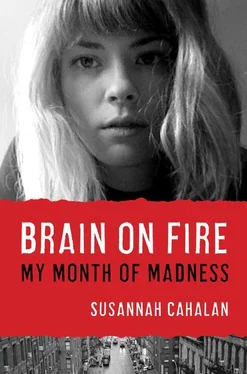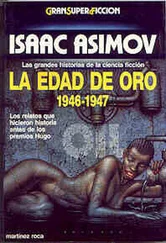He also sent me video footage of her skating with a note: “I thought you might like to see Emily skating. This is the first time I have seen her skate in two years. She is in the middle of the ice when the video starts. Also, as we were reflecting this past weekend since it was Mother’s Day, I remembered taking her in a wheelchair last Mother’s Day to the gift shop in the hospital to buy her mother a card, and she was unable to speak or walk. A year later, she is able to ice skate like you will see in this video. We continue to count our blessings.”
I clicked open the cell phone video and watched her. Emily wears a pink skirt, black leggings, and a black shirt, with a pink ribbon tied in her hair. She’s so natural on the ice that she seems to float just above its surface as she pirouettes, spinning and spinning in the center of the rink.

CHAPTER 49
HOMETOWN BOY MAKES GOOD
The Post ’s “Month of Madness” article changed not only my life but Dr. Najjar’s as well. After its publication, Dr. Najjar invited me to his house in Short Hills, New Jersey, about a five-minute drive from my mom’s Summit home. He answered the door and introduced me to his three teenage children and his wife, Marwa, a lovely woman with fair skin and light hair, several years younger than her husband. They met at the New York Infirmary Beekman Downtown Hospital (now part of NYU) in 1989, where he studied neuropathology and she worked in the lab. One afternoon, the shy Souhel made a joke in Arabic, and to his surprise, she laughed. She didn’t look Middle Eastern, but when he introduced himself, he found that she too came from Syria.
Marwa offered me tea as we sat in their living room by a grand piano. Midway through the conversation, Dr. Najjar mentioned his father, Salim Najjar, and seemed proud to share his incredible story.
Salim had grown up in an orphanage. His mother, who worked long hours at a nearby hospital making lab coats for doctors (coincidentally), had to give Salim up as a child when his father suddenly passed away. Alone, she could not support him on her meager income. Salim, who had so stressed education for his own sons, had never graduated from high school, but through sheer will and a tendency toward perfectionism, took up the construction trade and reached the pinnacle of his industry when his company built the city’s central airport, Damascus International. But none of this compared to his son’s successes overseas.
“My father saw your article. It was translated into Arabic in multiple papers. Not just one,” Dr. Najjar said. “There were, I mean, tears.”
“No way,” I said.
“Yeah, he had it framed and everything.”
After my article ran, the Syrian ambassador to the United Nations had reached out to Dr. Najjar to congratulate him on a job well done and then sent my Post article to SANSA, a Syrian news agency. Overnight, every news outlet there covered the story of how a Syrian boy had become a miracle doctor in America.
“Remember, this is the dunce. The class dunce who couldn’t do the work.” Marwa smiled. “The hometown boy makes good. You made it, baby, way to go.”
Later that same year, Dr. Najjar was named one of New York Magazine ’s best neurologists in the country.
By the time the Post published my piece, most people who knew me would have agreed, “Susannah is back.” I had returned to the Post full time, Dr. Najjar and Dr. Arslan had finally taken me off all medications, and I had even navigated the treacherous waters of live television in early 2010 when I was a guest on the Today show to discuss my illness.
Since my mom and Allen had decided to sell their Summit house, Stephen and I moved in with each other far sooner than either of us had anticipated. We both skirted the issue for months as I scrolled through ads looking for a studio apartment that would fit my tight budget. After a few weeks of searching, it became clear that I couldn’t afford to live alone. I dreaded bringing up the option to live together for fear that I would be pushing him to that next relationship step too soon. And I felt it wasn’t fair to press him: How could he say no? But when I impassively broached the subject with him he said, without hesitation, “That’s what I assumed we’d be doing.”
Still, Stephen was privately anxious about taking on the role of caregiver, despite how well I was doing. If something happened to me under our shared roof, he would be responsible. But he decided to press on: I was too broken, financially, emotionally, and physically, to live alone, and he wouldn’t have wanted us to be separated anyway.
So now you could add the grown-up step of living with my boyfriend to the list of reasons showing that I was “back.” But in reality it took several more months for me to assuredly say that I felt comfortable in my own skin again, when I finally could rely on myself not to wince when I ran into ex-boyfriends or cower in the back of a spin class.
This eureka moment happened quietly, more than a year after my diagnosis, when I was visiting my extended family in Santa Fe, New Mexico, for my cousin Blythe’s wedding in June 2010. At that wedding, unlike the one I had attended early in my recovery, there was no longer a chasm between the person I was inside and what people around me saw. I felt in control and at ease; I no longer struggled for the right words, didn’t have to push myself to make small talk, and had reclaimed my old sense of humor.
Because they had almost had to mourn me, friends and family feel relatively comfortable speaking openly about their relationships with and impressions of me. Because of this, I often felt like Tom Sawyer attending his own funeral; it’s a strange kind of gift. Two words keep repeating: outgoing and talkative. Almost every single person uses some variation of those words to describe me. I had never really known how much these terms had defined me and how jarring it must have been when I had suddenly become neither of those things.
I know that this new Susannah is a lot like the old Susannah. There are changes, but it’s more like a step to the left than an overhaul of my being. I talk fast again, can do my job with ease, feel comfortable in my own skin, and recognize myself in pictures. However, when I look at photographs taken of me “post,” versus pictures of me “pre,” there is something altered, something lost—or gained, I can’t tell—when I look into my eyes.
But recognizing myself in pictures, of course, does not signify a full return; I’m different than I was before. When I try to pinpoint all the subtle ways that I have changed, my hand instinctively sneaks up to that raw, bumpy bald spot on the front of my scalp that will never grow hair again. It is my permanent reminder that no matter how “normal” I feel, I will never be the same person that I was before.
However, there are far scarier things that concern me about this new Susannah. I talk in my sleep every night, something that I did not do before. One night, Stephen woke up to my screaming, “There’s a container of milk over there. A huge container of milk!” In a way, it’s funny, but given our experiences, also slightly sinister. And I have fears now that the carefree pre-illness Susannah did not have. A few months ago, a concerned parent called to update me about his daughter, who had relapsed. He shared another story about a woman who had made a full recovery for several years but recently had been stricken with the disease again while traveling abroad. Apparently relapses happen in about 20 percent of cases. 60Unlike cancer, there is no remission date. After a full recovery, you could relapse tomorrow as easily as five years from now. Those who did not have a teratoma, like me, have a higher rate of relapse, for reasons unknown, but at least those who do relapse tend to have the same rate of recovery as they did after the initial onset of the disease. This does little to ease my mind.
Читать дальше













